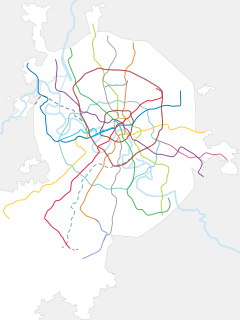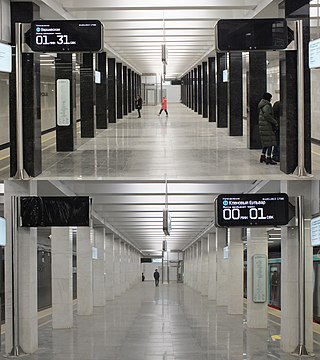
Kashirskaya is a cross-platform station complex on the Moscow Metro. It was opened on 11 August 1969 as part of the Kakhovsky radius extension, and from 1984 was an interchange between the Kakhovskaya and the Orekhovskaya branches of the Zamoskvoretskaya line. Since 2022 it is officially classed as three stations after the Bolshaya Koltsevaya line's separation, and also is the terminus of it.

The Tagansko-Krasnopresnenskaya line (Russian: Таганско-Краснопресненская линия, IPA:[tɐˈɡanskəkrəsnɐˈprʲesʲnʲɪnskəjəˈlʲinʲɪjə], formerly Zhdanovsko-Krasnopresnenskaya is the busiest line of the Moscow Metro. Built in 1966–1975 and extended in 2013–15, it cuts Moscow on a northwest-southeast axis and contains 23 stations.

Spartak, previously named Volokolamskaya, is a station on the Moscow Metro's Tagansko-Krasnopresnenskaya line, under the former Tushino airfield. It was originally constructed in 1975 as part of the northern extension of the Krasnopresnensky radius but was left unfinished for nearly 40 years. The planned opening of Otkrytiye Arena Stadium, the home ground of FC Spartak Moscow, at the site drove the completion of the station, which opened on 27 August 2014. Consequently, the station's name was changed from the planned Volokolamskaya to Spartak.

Volgogradsky Prospekt is a Moscow Metro station in the Nizhegorodsky District, South-Eastern Administrative Okrug, Moscow. It is on the Tagansko-Krasnopresnenskaya Line, between Proletarskaya and Kuzminki stations. Volgogradsky Prospekt was opened on 31 December 1966 as part of the Zhadovsky radius and is named after the nearby Avenue that leads on from the centre of Moscow into an intercity highway all the way to the southwest of Russia, although not directly to Volgograd. The station was built to a slight modification of the standard 1960s pillar-trispan decoration showing the first signs of innovative design, as architects V. Polikarpova and A. Marova did. The platform is narrowed. The white ceramic tiles on the walls are arranged on 45 degrees to the platform and are decorated with metallic artworks out of anodized aluminium depicting the Battle of Stalingrad. The pillars are faced with white marble whilst the floor with grey granite. The station has two underground vestibules with glazed concrete pavilions which allow passengers access to the Talalikhin and Novostapovskaya streets as well as directly to the AZLK automobile plant..

Tekstilshchiki is a Moscow Metro station in the Tekstilshchiki District, South-Eastern Administrative Okrug, Moscow. It is on Tagansko–Krasnopresnenskaya line, between Volgogradsky Prospekt and Kuzminki stations. Tekstilschiki was opened on 31 December 1966 as a part of the Zhdanovsky radius. The station is situated next to Tekstilshchiki railway station at the intersection of Volgogradsky avenue and Lyublinskaya street. A transfer to Tekstilshchiki is planned.

Ryazanskiy Prospekt is a station on Moscow Metro's Tagansko-Krasnopresnenskaya Line. Opened on 31 December 1966 as part of the Zhdanovsky radius, the station is situated where the line snakes northward and instead of following the Volgogradsky Avenue begins to follow the Ryazansky Avenue which runs several kilometres parallel to it on the north, another avenue and the original road to the city of Ryazan. Like all of the shallow-level stations built at the time, the design is a typical column tri-span, however like Volgogradsky Prospekt the platform has been narrowed. The composition of the station adopted the traditional Ryazan cloth theme to the wall decoration where the white tiles are distinctively articulated at the top with red patterns. Also prominent is the large black level the pillars are faced with grey-indigo marble and the floor is laid with grey and pink granite. Unusually the station has two surface vestibules, each on both sides of the Ryazanskoye Avenue as well as access to the Akademika Skryabina street. In March 2002 the station had a modest passenger traffic of 70,410.

Vykhino is a station on Moscow Metro's Tagansko-Krasnopresnenskaya line. Opened on 31 December 1966 as the final part of the Zhdanovsky Radius, the station was the southeastern terminus of the line until 9 November 2013, when the extension to Lermontovsky Prospekt and Zhulebino was opened. The metro station is part of a multi-modal transfer hub, which also consists of the mainline suburban railway.
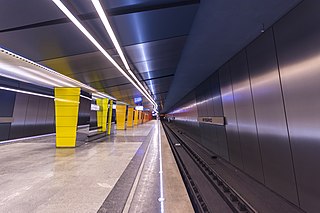
Zhulebino is a station on Moscow Metro's Tagansko-Krasnopresnenskaya Line. It is named after Zhulebino district and situated at the intersection of General Kuznetsov and Aircraft designer Mil streets. Zhulebino was opened on 9 November 2013. The construction lasted for two years. The station was to be opened on 6 November 2013, however due to a technical failure of a train at neighbouring Lermontovsky Prospekt station it was delayed until the 9th. Its location is outside the Moscow Ring Road beltway.

Kosino-Ukhtomsky District is an administrative district (raion) of Eastern Administrative Okrug, and one of the 125 raions of Moscow, Russia.

The Nekrasovskaya line is the fifteenth metro line of the Moscow Metro. The first segment, between Kosino and Nekrasovka, was opened on 3 June 2019. The second segment was opened on 27 March 2020. City officials expect it to relieve passenger traffic on the Tagansko-Krasnopresnenskaya line once completed.
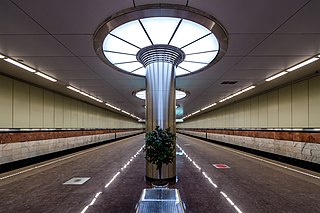
Kotelniki is a station on the Moscow Metro's Tagansko-Krasnopresnenskaya Line. The eastern terminus of the line, east of the station of Zhulebino, was opened on 21 September 2015. The station is located in the town of Kotelniki of Moscow Oblast. It is the second station of Moscow Metro in Moscow Oblast after Myakinino. In 1984, after the western part of the town of Lyubertsy was transferred to Moscow, rapid urban development started. The whole area, along with Lyubertsy and other areas along the Kazansky and Ryazansky suburban directions of Moscow Railway were strongly dependent on the station of Vykhino, then the terminus of the Tagansko-Krasnopresnenskaya Line and a transfer station to both railway directions. In the 2000s, Vykhino was heavily overloaded. Eventually, the decision was taken to extend the Tagansko-Krasnopresnenskaya Line beyond Vykhino. The construction of the first stretch, with the stations of Lermontovsky Prospekt and Zhulebino, was completed on 9 November 2013. The second stretch connected Zhulebino and Kotelniki.

Michurinsky Prospekt is a station on the Kalininsko-Solntsevskaya line of the Moscow Metro, it opened on 30 August 2018 as part of line's "Ramenki" - "Rasskazovka" extension.
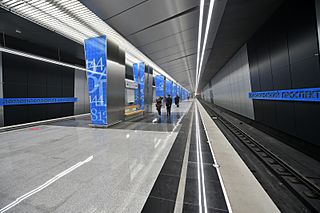
Lomonosovsky Prospekt is a station on the Kalininsko-Solntsevskaya Line of the Moscow Metro. It opened on 16 March 2017 as part of the line's extension between Park Pobedy and Ramenki. Tunneling between the station and that next from it, Ramenki, started in 2013.

Ugreshskaya is a station on the Moscow Central Circle that opened in September 2016.
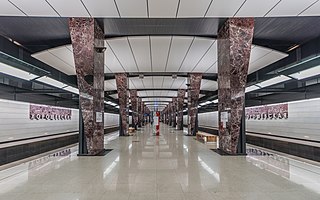
Khoroshyovskaya is a station on the Bolshaya Koltsevaya line of the Moscow Metro. It opened on 26 February 2018 as one of five initial stations on the new line.

Kosino is a station on the Nekrasovskaya line of the Moscow Metro. It was opened on 3 June 2019 as the western terminus of the inaugural stretch of the line, between Kosino and Nekrasovka. The station has a transfer to Lermontovsky Prospekt on the Tagansko-Krasnopresnenskaya line.

Michurinsky Prospekt is a Moscow Metro station of the Bolshaya Koltsevaya line. It was opened on 7 December 2021 as part of the section between Mnyovniki and Kakhovskaya. A transfer to Michurinsky Prospekt is opened on 7 December 2021.

The Kazansky suburban railway line is one of eleven railway lines used for suburban railway connections between Moscow, Russia, and surrounding areas, mostly in Moscow Oblast. The Kazansky suburban railway line connects Moscow with the stations in the east, in particular, with the towns of Lyubertsy, Kurovskoye, and Shatura. The stations the line serves are located in Moscow, as well as in Lyubertsy, Ramenskoye, Orekhovo-Zuyevo, and Shatura in Moscow Oblast. The suburban trains have their western terminus at Moscow Kazansky railway station in Moscow. In the eastern direction, the suburban trains terminate at Kurovskaya, Shatura, and Cherusti. There are also direct suburban trains to Yegoryevsk which from Kurovskaya follow Greater Ring of the Moscow Railway. The line is operated by Moscow Railway. The tracks between Moscow Kazansky railway station and Lyubertsy I are also used by Ryazansky suburban railway line.
The Ryazansky suburban railway line is one of eleven railway lines used for suburban railway connections between Moscow, Russia, and surrounding areas, mostly in Moscow Oblast. The Ryazansky suburban railway line connects Moscow with the stations in the south-east, in particular, with the towns of Lyubertsy, Kurovskoye, and Shatura. The stations the line serves are located in Moscow, in Lyubertsy, Ramenskoye, Voskresensk, Kolomna, and Lukhovitsy in Moscow Oblast, as well as Rybnovsky and Ryazansky Districts and the city of Ryazan in Ryazan Oblast. The suburban trains have their northwestern terminus at Moscow Kazansky railway station in Moscow. In the southeastern direction, the suburban trains terminate at Ippodrom, Faustovo, Vinogradovo, 88km, Shifernaya, Golutvin, Ryazan I, and Ryazan II. The line is operated by Moscow Railway. The tracks between Moscow Kazansky railway station and Lyubertsy I are also used by Kazansky suburban railway line.

